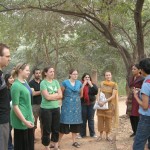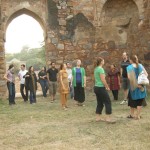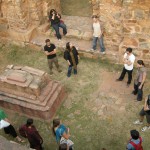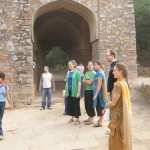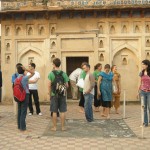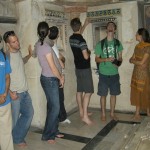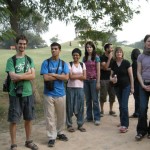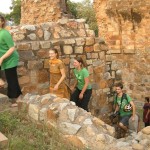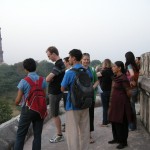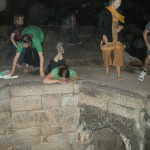Mehrauli Archaeological Park, 25 October 2009
- getting started
- at Balban’s tomb
- grave near Balban’s tomb
- new excavations
- Jamali’s tomb
- inside Jamali’s tomb
- at Metcalfe’s folly
- keep walking…
- up at dilkhusha, ‘delight of the heart!’
- wishing well?!!!
We started a bit later than the decided time: no one reached on time as no one seemed to know where the place was. Add to it the traffic jams in south Delhi and the result was a delay of good forty minutes. In fact, the first person to reach could do so only because he rode a bicycle and not a motor vehicle! Everyone complained that there is no signage to direct visitors to the park, until one of us pointed out the broken sandstone slab with the park’s name on it, lying on the ground. It was unanimously decided that this was in keeping with the ‘archaeological’ nature of the park and promptly stopped complaining!
A patch of land near the meeting point has been recently excavated. This is adjacent to Balban’s tomb. They have discovered a stone floor, a few cell-like structures and some graves. A couple of months back, this space was completely covered with vegetation and rocks. Now it is just ruins and heaps of mud. It is amazing to see how archaeological excavations alter an area. Reading about it is one thing, but to be able to see it in practice is totally different. An unexpected sight was newly made swings & a see-saw, with the labourers’ children playing on them. The contractor’s thoughtfulness, perhaps!
We next walked into Balban’s tomb, saw the grave which is said to be his son’s and looked at the ruins of a pre-19th century settlement. The Mehrauli archaeological Park is locally known as Jamali-Kamali and the monument that gives the place its name is the mosque and tomb of Maulana Jamali. The caretaker of the mosque is always on the guard and till last month there was police presence in all the ASI protected mosques in the neighbourhood. Some Muslim groups had recently tried to reclaim all historic mosques for restarting prayers, which is against the ASI rules. But now things seem a bit normalized and the compound was open for visitors. The tomb of Jamali is exquisitely decorated with incised plaster and tile work. It a wonder that is has managed to survive for more than 500 years. The small niches on the boundary wall of the compound look very cute. After Jamali-Kamali mosque we entered the area which formed part of Thomas Metcalfe’s Dilkhusha: his follies, the boathouse where one could imagine him enjoying his evening tea, the guest house and Mohammad Quli Khan’s tomb. The tomb retains traces of both original architecture and also Metcalfe’s additions to it. The view from the roof of the tomb is excellent: the Qutb Minar is quite close, the Mahavir statue and tomb nearby on a hill, the Chhatarpur Mandir, Adham Khan’s tomb. The canopy of trees looked like a vast green carpet dotted with monuments. The final stop was the step well called Rajon ki baoli. The baoli is a highpoint of one’s visit to the park. The underground arched terraces reveal themselves gradually as one approaches the baoli. The same compound has a tomb and a mosque which has beautiful plaster decorations. The well of the baoli caused some excitement (see picture) and we had everyone getting down on their knees to peek safely into it.
(posted by Kanika Singh & photos by Rajesh Ranjan, team members, Delhi Heritage Walks)
